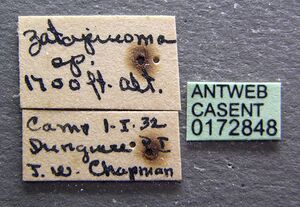Tapinoma williamsi
| Tapinoma williamsi | |
|---|---|

| |
| Scientific classification | |
| Kingdom: | Animalia |
| Phylum: | Arthropoda |
| Class: | Insecta |
| Order: | Hymenoptera |
| Family: | Formicidae |
| Subfamily: | Dolichoderinae |
| Genus: | Tapinoma |
| Species: | T. williamsi |
| Binomial name | |
| Tapinoma williamsi (Wheeler, W.M., 1935) | |
Identification
This species is very close to Tapinoma wheeleri described from soldiers received from Samoa by the Federal Quarantine Station in Honolulu. This species, however, has 5-toothed mandibles and the funicular joints 2-10 are distinctly broader than long as in Tapinoma annandalei. (Wheeler 1935)
Distribution
Distribution based on Regional Taxon Lists
Indo-Australian Region: Malaysia, Philippines (type locality).
Distribution based on AntMaps
Distribution based on AntWeb specimens
Check data from AntWeb
Countries Occupied
| Number of countries occupied by this species based on AntWiki Regional Taxon Lists. In general, fewer countries occupied indicates a narrower range, while more countries indicates a more widespread species. |

|
Estimated Abundance
| Relative abundance based on number of AntMaps records per species (this species within the purple bar). Fewer records (to the left) indicates a less abundant/encountered species while more records (to the right) indicates more abundant/encountered species. |

|
Biology
Castes
Worker
Images from AntWeb
   
| |
| Worker. Specimen code casent0172848. Photographer April Nobile, uploaded by California Academy of Sciences. | Owned by MCZ, Cambridge, MA, USA. |
Queen
Images from AntWeb
   
| |
| Cotype of Tapinoma williamsi. Queen (alate/dealate). Specimen code casent0172847. Photographer April Nobile, uploaded by California Academy of Sciences. | Owned by MCZ, Cambridge, MA, USA. |
Nomenclature
The following information is derived from Barry Bolton's Online Catalogue of the Ants of the World.
- williamsi. Zatapinoma williamsi Wheeler, W.M. 1935b: 44 (s.w.) PHILIPPINES. Combination in Tapinoma: Shattuck, 1992c: 152.
Unless otherwise noted the text for the remainder of this section is reported from the publication that includes the original description.
Description
Worker
Length nearly 3 mm.
Very similar to the soldier of Tapinoma annandalei of India but differing in the following characters: Integument thicker and more rigid, clypeal swellings somewhat less pronounced and not bilobed or biprotuberant on each side; mandibles with 8 coarse teeth, the first, second and fourth larger than the others, the seventh and eighth fused; frontal area obsolete; funicular joints 3-8 as long as broad (in annandalei distinctly broader than long); eyes distinctly larger, situated a distance equal to their greatest diameter from the posterior clypeal border, which is more distinct than in the Indian species. Thorax more slender, the pronotum as long as broad, the epinotum slightly longer than broad.
Sculpture and pilosity very similar in the two species, but the color of williamsi is different, being brownish yellow instead of whitish yellow, the mandibles and clypeus are concolorous with the remainder of the head and the second to fourth gastric segments are brown at the base.
Queen
Length 3.5 mm.
Resembling the soldier, but the head is proportionally smaller and somewhat more narrowed anteriorly, the eyes though flat are much larger, twice as long as their distance from the anterior corners of the head. Ocelli well-developed, near the occipital border. Clypeus without the peculiar lateral swellings of the soldier, feebly convex in the middle, depressed on each side. Frontal area large and indistinct. Antennal scapes reaching to the posterior fourth of the head. Thorax collapsed, but apparently as broad as the head, with flattened mesonotum. Gaster large, shaped like that of the soldier. Wings long, the anterior pair with long closed radial cell, a single long cubital but no discoidal cell. There are no traces of a pterostigma.
Sculpture and pilosity much as in the soldier, but the pubescence is more abundant and longer, especially on the gaster and the segments of this region also bear sparse and rather long, coarse hairs. Wings pubescent.
Clypeus and thorax brown; antennae, head and legs brownish yellow; gaster pale yellow, with a broad, dark brown basal fascia on each segment. Wings hyaline, with very pale yellow veins.
Type Material
Single soldier and female specimens taken by Dr. F. X. Williams as Los Banos, Luzon Island, Philippines. As I am not certain that the two specimens collected by Dr. Williams are from the same colony, only the soldier is to be regarded as the type.
References
- Baltazar, C.R. 1966. A catalogue of Philippine Hymenoptera (with a bibliography, 1758-1963). Pacific Insects Monographs 8: 1-488. (page 264, listed)
- Cantone S. 2018. Winged Ants, The queen. Dichotomous key to genera of winged female ants in the World. The Wings of Ants: morphological and systematic relationships (self-published).
- Shattuck, S. O. 1992c. Generic revision of the ant subfamily Dolichoderinae (Hymenoptera: Formicidae). Sociobiology 21: 1-181 (page 152, Combination in Tapinoma.)
- Wheeler, W. M. 1935b. New ants from the Philippines. Psyche (Camb.) 42: 38-52 (page 44, soldier, worker described)
References based on Global Ant Biodiversity Informatics
- Chapman, J. W., and Capco, S. R. 1951. Check list of the ants (Hymenoptera: Formicidae) of Asia. Monogr. Inst. Sci. Technol. Manila 1: 1-327

